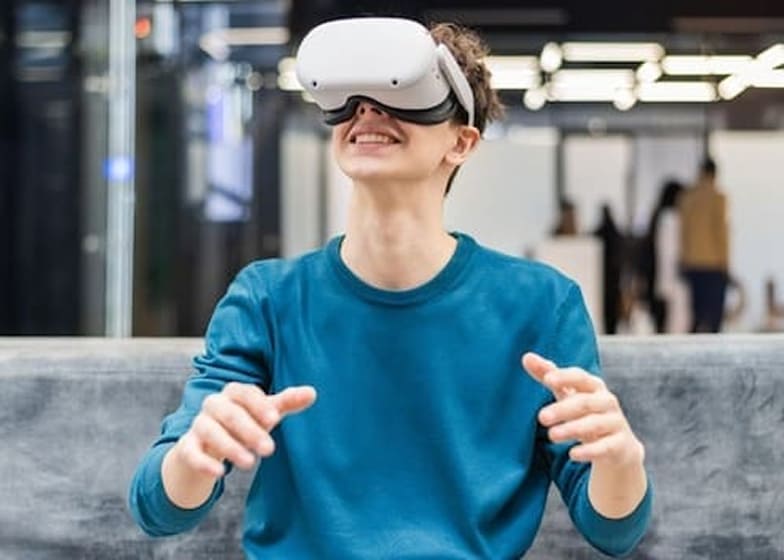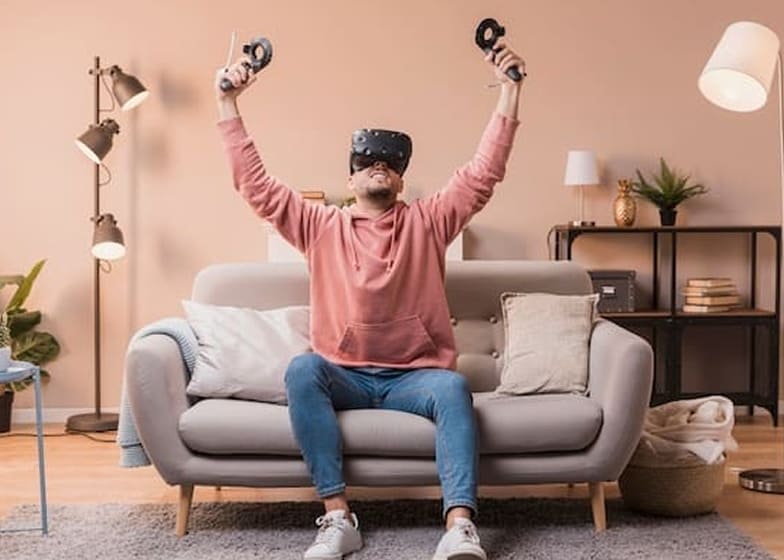Augmented Reality (AR) and Virtual Reality (VR) are two immersive technologies that are transforming the way we interact with digital content, but they serve different purposes and experiences. AR overlays digital elements, such as images, information, or animations, onto the real-world environment. This allows users to interact with both the physical and digital worlds simultaneously. Popular examples of AR include smartphone apps like Pokémon Go, Snapchat filters, and AR-enabled shopping apps that let users visualize furniture or clothing in real life before purchasing.
In contrast, Virtual Reality (VR) immerses users in a completely digital environment, replacing the physical world with a simulated one. Using VR headsets like Oculus Rift, HTC Vive, or PlayStation VR, users can experience gaming, virtual tours, or training simulations as if they are physically present in a different environment. VR is widely used in entertainment, education, real estate, and professional training, offering experiences that are fully immersive and interactive.
The key difference between AR and VR lies in user interaction and environment. AR enhances the real world by adding digital elements without removing physical surroundings, whereas VR creates a separate virtual world entirely. AR is often more accessible because it can run on smartphones or tablets, while VR typically requires specialized hardware to provide a fully immersive experience. Both technologies, however, aim to enhance engagement, learning, and entertainment in unique ways.
Beyond entertainment, both AR and VR have significant applications in business and education. AR can improve productivity through real-time instructions and remote assistance in manufacturing or maintenance, while VR can simulate complex scenarios for training medical professionals, pilots, or engineers. As these technologies evolve, businesses can leverage them to improve customer experiences, streamline operations, and even generate new revenue streams through immersive products and services.
Augmented Reality
Augmented Reality (AR) is a technology that overlays digital information—such as images, text, animations, or 3D models—onto the real-world environment, enhancing the user’s perception and interaction with their surroundings. Unlike Virtual Reality (VR), which creates a fully immersive digital environment, AR blends digital content with the physical world, allowing users to see and interact with both simultaneously.
AR is widely used in smartphones, tablets, and smart glasses. Popular applications include interactive gaming (like Pokémon Go), shopping apps that let users visualize furniture or clothing in their homes, educational tools that display 3D models of objects, and AR navigation systems that overlay directions on real-world streets. AR enhances experiences by providing contextual information, improving engagement, and enabling real-time interactions without replacing the real environment.
Businesses leveraging AR can increase customer engagement, reduce product return rates (through virtual try-ons), and create innovative marketing campaigns. For example, AR-enabled retail solutions can boost sales and generate additional revenue of $50K–$500K+ annually, depending on scale and adoption.
Virtual Reality
Virtual Reality (VR) is a technology that immerses users in a completely digital environment, replacing the real world with a simulated, interactive experience. Users typically wear VR headsets or goggles, often combined with motion controllers or haptic devices, to navigate and interact with the virtual space. Unlike Augmented Reality (AR), which overlays digital elements onto the real world, VR creates a fully artificial environment that can simulate real-life scenarios or entirely fictional worlds.
VR is widely used in gaming, entertainment, education, and professional training. For example, VR allows gamers to experience fully immersive game worlds, students to explore virtual historical sites, and medical professionals or pilots to practice procedures or flight simulations in a safe, controlled setting. The technology enables users to experience situations that would otherwise be costly, dangerous, or impossible in the physical world.
Businesses adopting VR can generate revenue through immersive experiences, training programs, virtual tours, and entertainment platforms. For instance, VR training solutions in healthcare or aviation can save institutions $50K–$500K annually by reducing errors, enhancing learning efficiency, and lowering physical training costs.
AR and VR Are Used in Different Industries
Augmented Reality (AR) and Virtual Reality (VR) have distinct applications across various industries due to the way they interact with the real and digital worlds.
Retail and E-commerce
AR is widely used in retail to let customers virtually try on clothing, accessories, or visualize furniture and home décor in their own spaces. VR, on the other hand, can create fully immersive virtual stores where customers can explore products in a simulated environment. These technologies enhance customer engagement and can significantly increase sales.
Healthcare
AR assists surgeons by overlaying digital information on patient anatomy during operations and enables remote medical guidance. VR is used for medical training, simulating surgeries, and providing exposure therapy for patients, allowing safe practice and treatment without real-world risk.
Education and Training
AR enriches textbooks and learning materials with interactive 3D models and real-time data, while VR immerses students in historical events, virtual labs, or complex scientific simulations. Both enhance engagement and understanding but in different ways.
Manufacturing and Maintenance
AR provides real-time instructions and overlays on machinery to guide workers during assembly or repairs. VR allows engineers and designers to simulate workflows, factory layouts, or machinery testing in a virtual environment before implementation, reducing errors and costs.
Entertainment and Gaming
AR overlays interactive elements on the real world for mobile games, live events, or social media filters. VR creates fully immersive gaming experiences, virtual concerts, or cinematic experiences, offering complete sensory engagement.
Real Estate and Architecture
AR allows potential buyers to visualize properties with furniture, modifications, or renovations in their real environment. VR provides virtual property tours, architectural walkthroughs, and simulations of new building designs, enabling clients to explore spaces remotely.
Advantages of Augmented Reality
- Enhanced User Experience: AR overlays digital content onto the real world, making interactions more engaging and informative. Users can visualize products, learn concepts interactively, or receive real-time guidance.
- Improved Training and Education : AR provides interactive simulations for education and professional training. For example, medical students can study anatomy using 3D models overlaid on physical textbooks.
- Increased Customer Engagement and Sales : Retailers use AR for virtual try-ons or product visualization, which enhances shopping experiences, reduces returns, and boosts sales.
- Real-Time Assistance and Maintenance : AR can guide technicians by overlaying step-by-step instructions on equipment, reducing errors and downtime in industrial or technical settings.
- $ Perspective : Businesses leveraging AR can increase revenue, reduce operational costs, and enhance customer satisfaction, potentially generating $50K–$500K/year depending on scale.
Advantages of Virtual Reality
- Fully Immersive Experiences : VR creates a complete digital environment, allowing users to experience simulations, gaming, or training in a realistic, immersive way.
- Safe Training and Simulation : VR enables practice in risk-free environments, ideal for medical procedures, aviation, military, or hazardous industrial training.
- Remote Exploration and Collaboration : VR allows virtual tours of real estate, museums, or remote sites and supports collaborative workspaces for teams across the globe.
- Enhanced Entertainment and Engagement : VR offers immersive gaming, virtual concerts, and cinematic experiences, giving users a sense of presence and interactivity that traditional media cannot provide.
- $ Perspective : Companies using VR for training, real estate tours, or entertainment can save costs and generate new revenue streams, ranging from $50K–$500K+ annually depending on usage and audience size.
Challenges of Augmented Reality
- Hardware Limitations : AR requires devices like smartphones, tablets, or smart glasses with sufficient processing power, sensors, and cameras. Limited device capabilities can restrict AR performance and user experience.
- High Development Costs : Creating AR applications, 3D models, and interactive content can be expensive, requiring skilled developers, designers, and software tools.
- User Privacy Concerns : AR collects data from real-world environments, including location, surroundings, and personal interactions, raising privacy and security issues.
- Limited Standardization and Compatibility : AR platforms may not be compatible across devices or operating systems, leading to fragmented experiences for users.
Challenges of Augmented Reality
- Expensive Hardware : VR requires dedicated headsets, motion controllers, and sometimes high-performance computers, making adoption costly for individuals and businesses.
- Motion Sickness and Discomfort : Some users experience nausea, dizziness, or eye strain during prolonged VR sessions, limiting usability and engagement.
- Content Creation Complexity : Developing immersive VR environments requires advanced 3D modeling, animation, and programming skills, which can be resource-intensive.
- Limited Accessibility : VR adoption is restricted by cost, space requirements, and the need for technical expertise, making it less accessible for casual users or small businesses.
Summary
Augmented Reality (AR) and Virtual Reality (VR) are immersive technologies that enhance digital interaction in distinct ways. AR overlays digital content onto the real world, enhancing user experiences, providing real-time information, and supporting applications like virtual try-ons, industrial guidance, and educational tools. VR, on the other hand, fully immerses users in a digital environment, ideal for gaming, training simulations, virtual tours, and immersive entertainment. Both technologies offer significant benefits, including improved engagement, training efficiency, and new business opportunities, but they also face challenges such as high development costs, hardware requirements, and privacy concerns. As AR and VR continue to evolve, they are reshaping industries, creating innovative user experiences, and unlocking potential revenue streams across retail, healthcare, education, manufacturing, and entertainment.
















